Financial Reporting Report: Alpha Ltd. Hardware Manufacturing
VerifiedAdded on 2020/06/04
|13
|3879
|473
Report
AI Summary
This report provides a comprehensive analysis of financial reporting, focusing on the context, purpose, and standards of financial accounting. It examines the role of financial reporting in achieving organizational objectives and ensuring compliance with relevant legislation. The report interprets profit and loss, cash flow, and balance sheet statements, using Alpha Ltd. as a case study, and calculates and presents key financial ratios to assess organizational performance and investment potential. It also explores the benefits of International Accounting Standards (IAS) and International Financial Reporting Standards (IFRS), evaluates financial reporting and auditing models, and discusses the significance of financial reporting across different countries. The report concludes with an overview of the key findings and recommendations for effective financial management. The report is available on Desklib, a platform offering AI-powered study tools and resources for students, including past papers and solved assignments.

FINANCIAL REPORTING
Paraphrase This Document
Need a fresh take? Get an instant paraphrase of this document with our AI Paraphraser
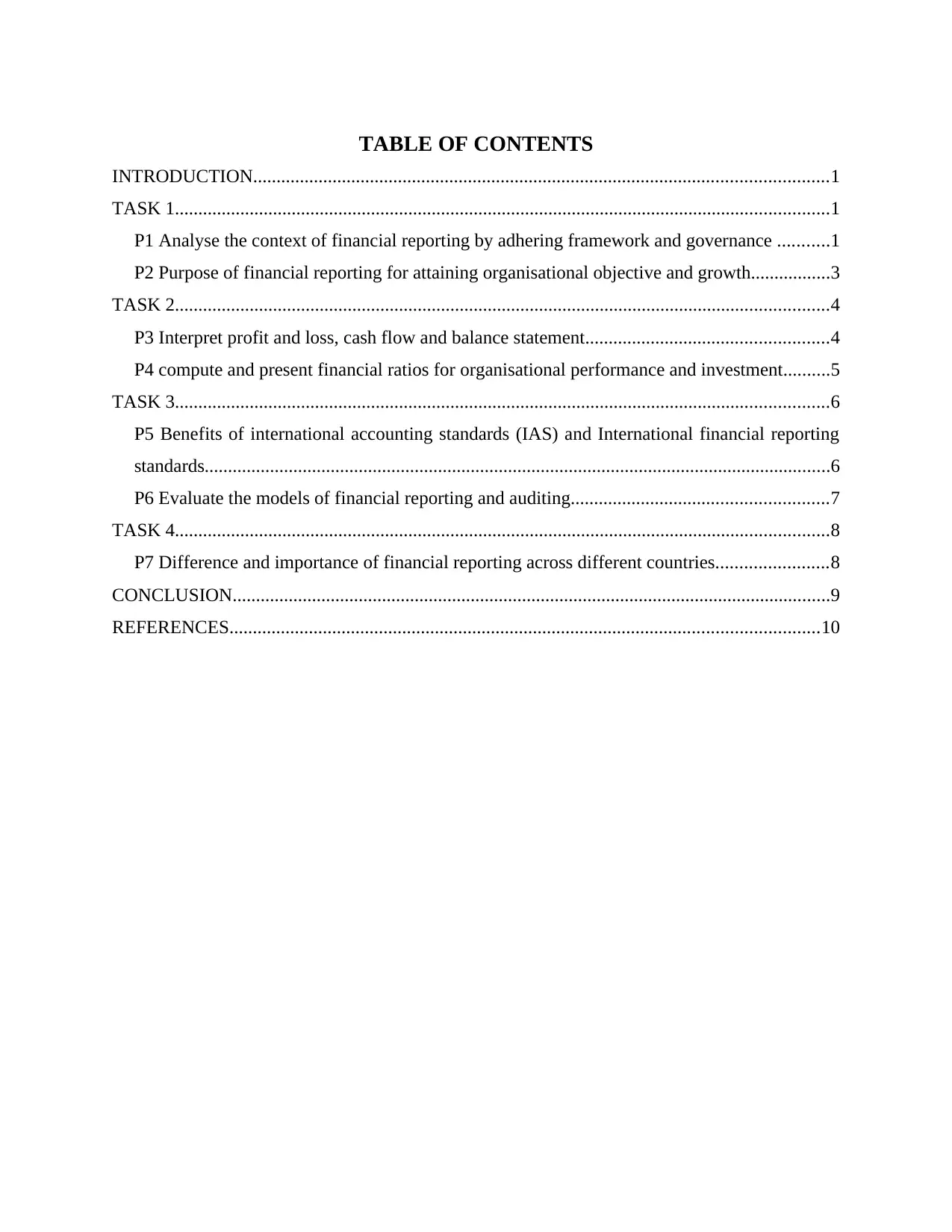
TABLE OF CONTENTS
INTRODUCTION...........................................................................................................................1
TASK 1............................................................................................................................................1
P1 Analyse the context of financial reporting by adhering framework and governance ...........1
P2 Purpose of financial reporting for attaining organisational objective and growth.................3
TASK 2............................................................................................................................................4
P3 Interpret profit and loss, cash flow and balance statement....................................................4
P4 compute and present financial ratios for organisational performance and investment..........5
TASK 3............................................................................................................................................6
P5 Benefits of international accounting standards (IAS) and International financial reporting
standards......................................................................................................................................6
P6 Evaluate the models of financial reporting and auditing.......................................................7
TASK 4............................................................................................................................................8
P7 Difference and importance of financial reporting across different countries........................8
CONCLUSION................................................................................................................................9
REFERENCES..............................................................................................................................10
INTRODUCTION...........................................................................................................................1
TASK 1............................................................................................................................................1
P1 Analyse the context of financial reporting by adhering framework and governance ...........1
P2 Purpose of financial reporting for attaining organisational objective and growth.................3
TASK 2............................................................................................................................................4
P3 Interpret profit and loss, cash flow and balance statement....................................................4
P4 compute and present financial ratios for organisational performance and investment..........5
TASK 3............................................................................................................................................6
P5 Benefits of international accounting standards (IAS) and International financial reporting
standards......................................................................................................................................6
P6 Evaluate the models of financial reporting and auditing.......................................................7
TASK 4............................................................................................................................................8
P7 Difference and importance of financial reporting across different countries........................8
CONCLUSION................................................................................................................................9
REFERENCES..............................................................................................................................10
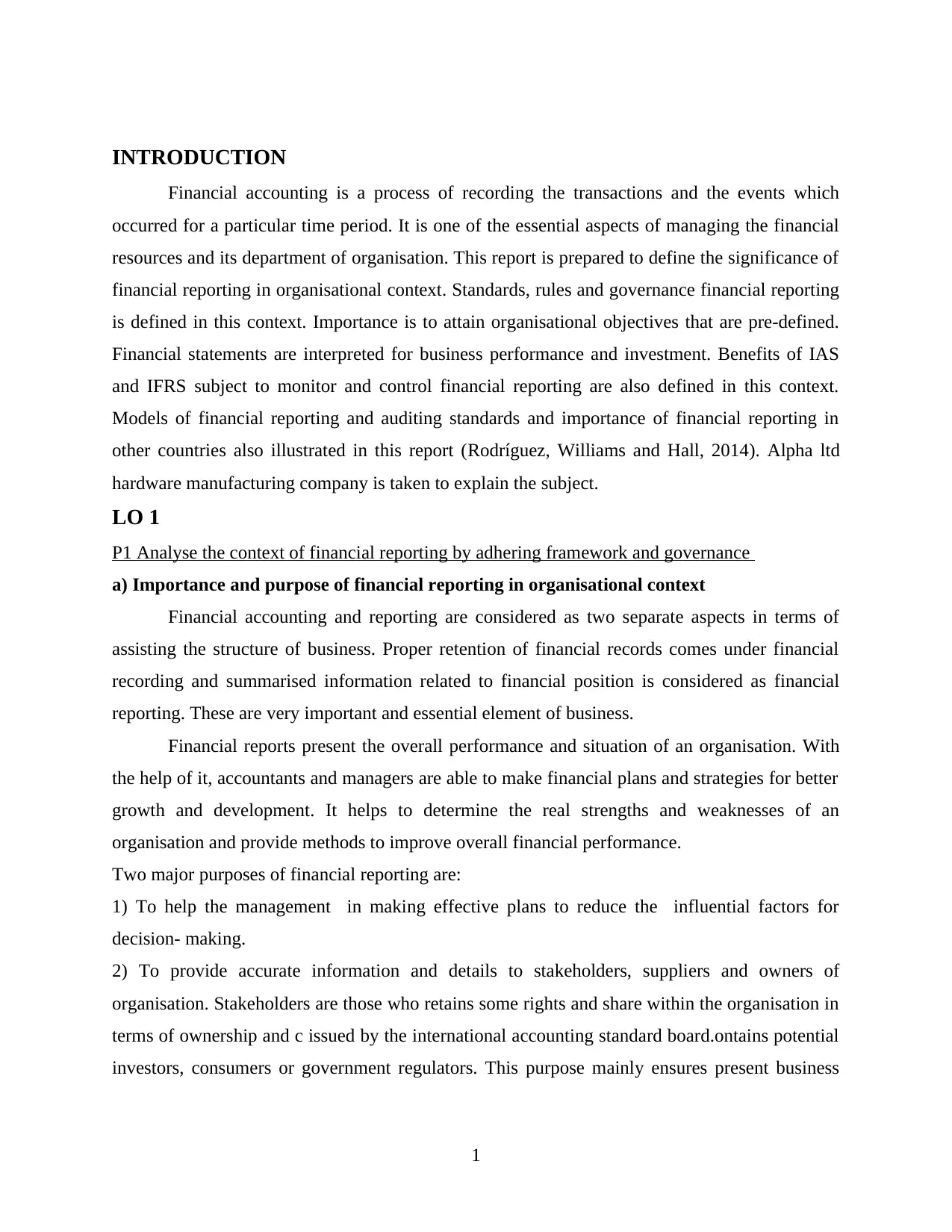
INTRODUCTION
Financial accounting is a process of recording the transactions and the events which
occurred for a particular time period. It is one of the essential aspects of managing the financial
resources and its department of organisation. This report is prepared to define the significance of
financial reporting in organisational context. Standards, rules and governance financial reporting
is defined in this context. Importance is to attain organisational objectives that are pre-defined.
Financial statements are interpreted for business performance and investment. Benefits of IAS
and IFRS subject to monitor and control financial reporting are also defined in this context.
Models of financial reporting and auditing standards and importance of financial reporting in
other countries also illustrated in this report (Rodríguez, Williams and Hall, 2014). Alpha ltd
hardware manufacturing company is taken to explain the subject.
LO 1
P1 Analyse the context of financial reporting by adhering framework and governance
a) Importance and purpose of financial reporting in organisational context
Financial accounting and reporting are considered as two separate aspects in terms of
assisting the structure of business. Proper retention of financial records comes under financial
recording and summarised information related to financial position is considered as financial
reporting. These are very important and essential element of business.
Financial reports present the overall performance and situation of an organisation. With
the help of it, accountants and managers are able to make financial plans and strategies for better
growth and development. It helps to determine the real strengths and weaknesses of an
organisation and provide methods to improve overall financial performance.
Two major purposes of financial reporting are:
1) To help the management in making effective plans to reduce the influential factors for
decision- making.
2) To provide accurate information and details to stakeholders, suppliers and owners of
organisation. Stakeholders are those who retains some rights and share within the organisation in
terms of ownership and c issued by the international accounting standard board.ontains potential
investors, consumers or government regulators. This purpose mainly ensures present business
1
Financial accounting is a process of recording the transactions and the events which
occurred for a particular time period. It is one of the essential aspects of managing the financial
resources and its department of organisation. This report is prepared to define the significance of
financial reporting in organisational context. Standards, rules and governance financial reporting
is defined in this context. Importance is to attain organisational objectives that are pre-defined.
Financial statements are interpreted for business performance and investment. Benefits of IAS
and IFRS subject to monitor and control financial reporting are also defined in this context.
Models of financial reporting and auditing standards and importance of financial reporting in
other countries also illustrated in this report (Rodríguez, Williams and Hall, 2014). Alpha ltd
hardware manufacturing company is taken to explain the subject.
LO 1
P1 Analyse the context of financial reporting by adhering framework and governance
a) Importance and purpose of financial reporting in organisational context
Financial accounting and reporting are considered as two separate aspects in terms of
assisting the structure of business. Proper retention of financial records comes under financial
recording and summarised information related to financial position is considered as financial
reporting. These are very important and essential element of business.
Financial reports present the overall performance and situation of an organisation. With
the help of it, accountants and managers are able to make financial plans and strategies for better
growth and development. It helps to determine the real strengths and weaknesses of an
organisation and provide methods to improve overall financial performance.
Two major purposes of financial reporting are:
1) To help the management in making effective plans to reduce the influential factors for
decision- making.
2) To provide accurate information and details to stakeholders, suppliers and owners of
organisation. Stakeholders are those who retains some rights and share within the organisation in
terms of ownership and c issued by the international accounting standard board.ontains potential
investors, consumers or government regulators. This purpose mainly ensures present business
1
⊘ This is a preview!⊘
Do you want full access?
Subscribe today to unlock all pages.

Trusted by 1+ million students worldwide
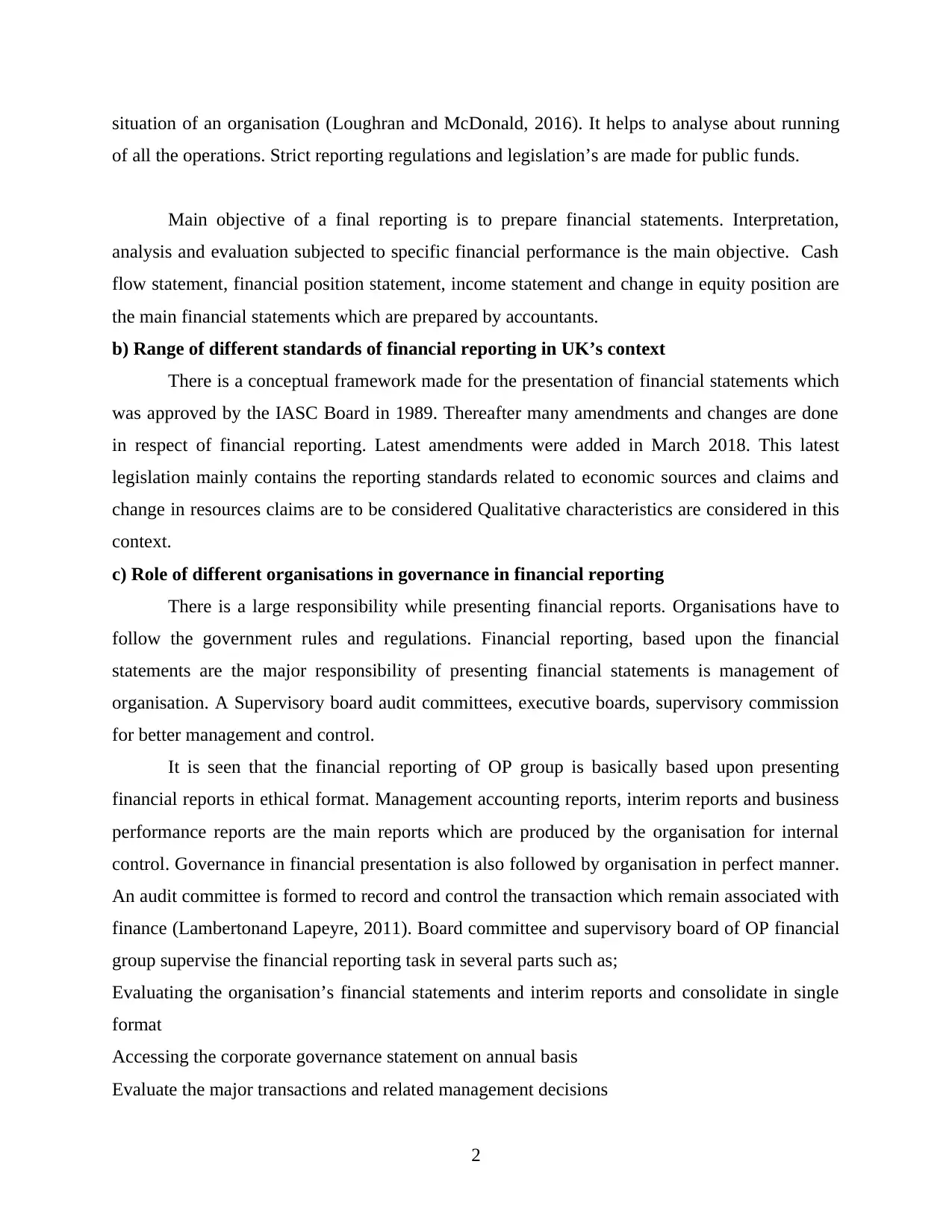
situation of an organisation (Loughran and McDonald, 2016). It helps to analyse about running
of all the operations. Strict reporting regulations and legislation’s are made for public funds.
Main objective of a final reporting is to prepare financial statements. Interpretation,
analysis and evaluation subjected to specific financial performance is the main objective. Cash
flow statement, financial position statement, income statement and change in equity position are
the main financial statements which are prepared by accountants.
b) Range of different standards of financial reporting in UK’s context
There is a conceptual framework made for the presentation of financial statements which
was approved by the IASC Board in 1989. Thereafter many amendments and changes are done
in respect of financial reporting. Latest amendments were added in March 2018. This latest
legislation mainly contains the reporting standards related to economic sources and claims and
change in resources claims are to be considered Qualitative characteristics are considered in this
context.
c) Role of different organisations in governance in financial reporting
There is a large responsibility while presenting financial reports. Organisations have to
follow the government rules and regulations. Financial reporting, based upon the financial
statements are the major responsibility of presenting financial statements is management of
organisation. A Supervisory board audit committees, executive boards, supervisory commission
for better management and control.
It is seen that the financial reporting of OP group is basically based upon presenting
financial reports in ethical format. Management accounting reports, interim reports and business
performance reports are the main reports which are produced by the organisation for internal
control. Governance in financial presentation is also followed by organisation in perfect manner.
An audit committee is formed to record and control the transaction which remain associated with
finance (Lambertonand Lapeyre, 2011). Board committee and supervisory board of OP financial
group supervise the financial reporting task in several parts such as;
Evaluating the organisation’s financial statements and interim reports and consolidate in single
format
Accessing the corporate governance statement on annual basis
Evaluate the major transactions and related management decisions
2
of all the operations. Strict reporting regulations and legislation’s are made for public funds.
Main objective of a final reporting is to prepare financial statements. Interpretation,
analysis and evaluation subjected to specific financial performance is the main objective. Cash
flow statement, financial position statement, income statement and change in equity position are
the main financial statements which are prepared by accountants.
b) Range of different standards of financial reporting in UK’s context
There is a conceptual framework made for the presentation of financial statements which
was approved by the IASC Board in 1989. Thereafter many amendments and changes are done
in respect of financial reporting. Latest amendments were added in March 2018. This latest
legislation mainly contains the reporting standards related to economic sources and claims and
change in resources claims are to be considered Qualitative characteristics are considered in this
context.
c) Role of different organisations in governance in financial reporting
There is a large responsibility while presenting financial reports. Organisations have to
follow the government rules and regulations. Financial reporting, based upon the financial
statements are the major responsibility of presenting financial statements is management of
organisation. A Supervisory board audit committees, executive boards, supervisory commission
for better management and control.
It is seen that the financial reporting of OP group is basically based upon presenting
financial reports in ethical format. Management accounting reports, interim reports and business
performance reports are the main reports which are produced by the organisation for internal
control. Governance in financial presentation is also followed by organisation in perfect manner.
An audit committee is formed to record and control the transaction which remain associated with
finance (Lambertonand Lapeyre, 2011). Board committee and supervisory board of OP financial
group supervise the financial reporting task in several parts such as;
Evaluating the organisation’s financial statements and interim reports and consolidate in single
format
Accessing the corporate governance statement on annual basis
Evaluate the major transactions and related management decisions
2
Paraphrase This Document
Need a fresh take? Get an instant paraphrase of this document with our AI Paraphraser
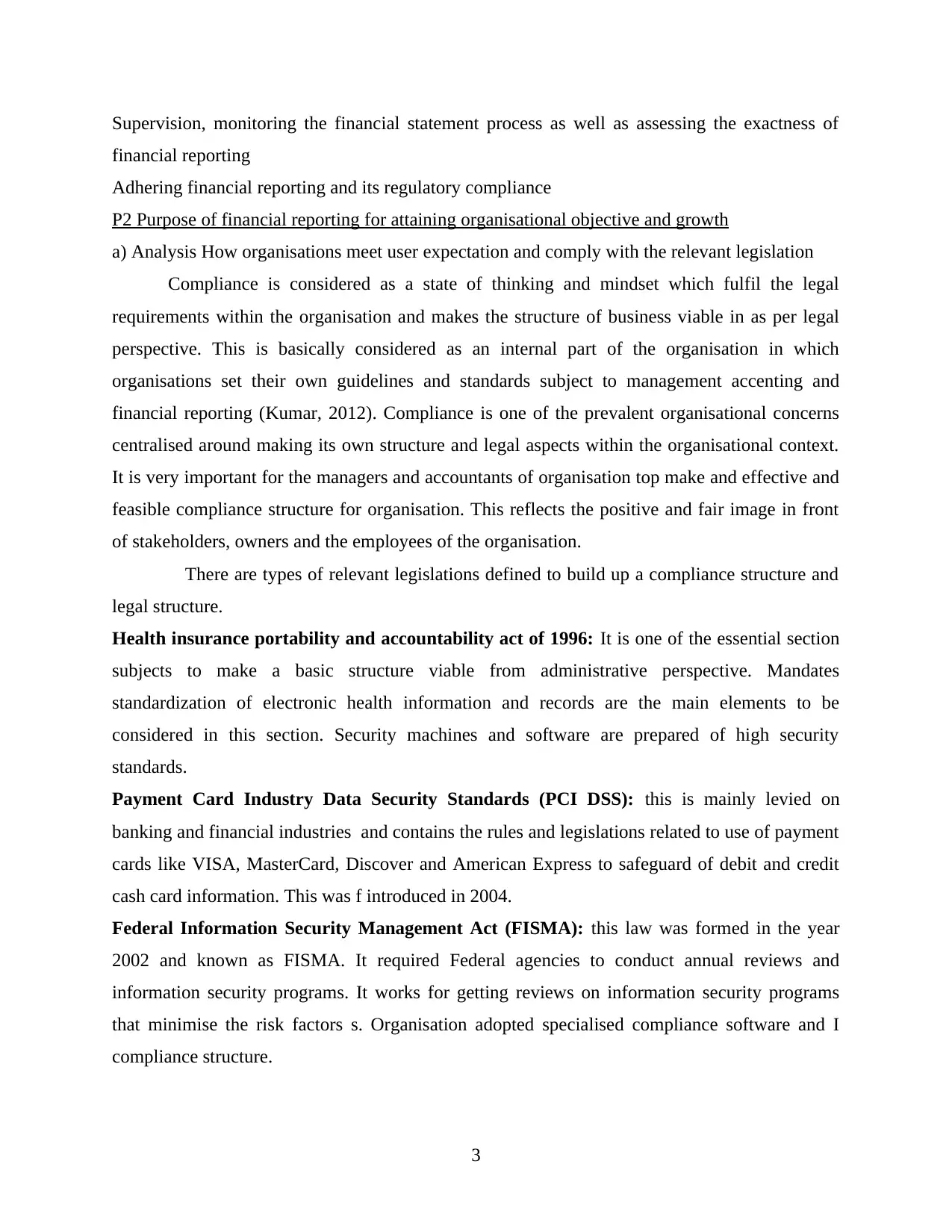
Supervision, monitoring the financial statement process as well as assessing the exactness of
financial reporting
Adhering financial reporting and its regulatory compliance
P2 Purpose of financial reporting for attaining organisational objective and growth
a) Analysis How organisations meet user expectation and comply with the relevant legislation
Compliance is considered as a state of thinking and mindset which fulfil the legal
requirements within the organisation and makes the structure of business viable in as per legal
perspective. This is basically considered as an internal part of the organisation in which
organisations set their own guidelines and standards subject to management accenting and
financial reporting (Kumar, 2012). Compliance is one of the prevalent organisational concerns
centralised around making its own structure and legal aspects within the organisational context.
It is very important for the managers and accountants of organisation top make and effective and
feasible compliance structure for organisation. This reflects the positive and fair image in front
of stakeholders, owners and the employees of the organisation.
There are types of relevant legislations defined to build up a compliance structure and
legal structure.
Health insurance portability and accountability act of 1996: It is one of the essential section
subjects to make a basic structure viable from administrative perspective. Mandates
standardization of electronic health information and records are the main elements to be
considered in this section. Security machines and software are prepared of high security
standards.
Payment Card Industry Data Security Standards (PCI DSS): this is mainly levied on
banking and financial industries and contains the rules and legislations related to use of payment
cards like VISA, MasterCard, Discover and American Express to safeguard of debit and credit
cash card information. This was f introduced in 2004.
Federal Information Security Management Act (FISMA): this law was formed in the year
2002 and known as FISMA. It required Federal agencies to conduct annual reviews and
information security programs. It works for getting reviews on information security programs
that minimise the risk factors s. Organisation adopted specialised compliance software and I
compliance structure.
3
financial reporting
Adhering financial reporting and its regulatory compliance
P2 Purpose of financial reporting for attaining organisational objective and growth
a) Analysis How organisations meet user expectation and comply with the relevant legislation
Compliance is considered as a state of thinking and mindset which fulfil the legal
requirements within the organisation and makes the structure of business viable in as per legal
perspective. This is basically considered as an internal part of the organisation in which
organisations set their own guidelines and standards subject to management accenting and
financial reporting (Kumar, 2012). Compliance is one of the prevalent organisational concerns
centralised around making its own structure and legal aspects within the organisational context.
It is very important for the managers and accountants of organisation top make and effective and
feasible compliance structure for organisation. This reflects the positive and fair image in front
of stakeholders, owners and the employees of the organisation.
There are types of relevant legislations defined to build up a compliance structure and
legal structure.
Health insurance portability and accountability act of 1996: It is one of the essential section
subjects to make a basic structure viable from administrative perspective. Mandates
standardization of electronic health information and records are the main elements to be
considered in this section. Security machines and software are prepared of high security
standards.
Payment Card Industry Data Security Standards (PCI DSS): this is mainly levied on
banking and financial industries and contains the rules and legislations related to use of payment
cards like VISA, MasterCard, Discover and American Express to safeguard of debit and credit
cash card information. This was f introduced in 2004.
Federal Information Security Management Act (FISMA): this law was formed in the year
2002 and known as FISMA. It required Federal agencies to conduct annual reviews and
information security programs. It works for getting reviews on information security programs
that minimise the risk factors s. Organisation adopted specialised compliance software and I
compliance structure.
3
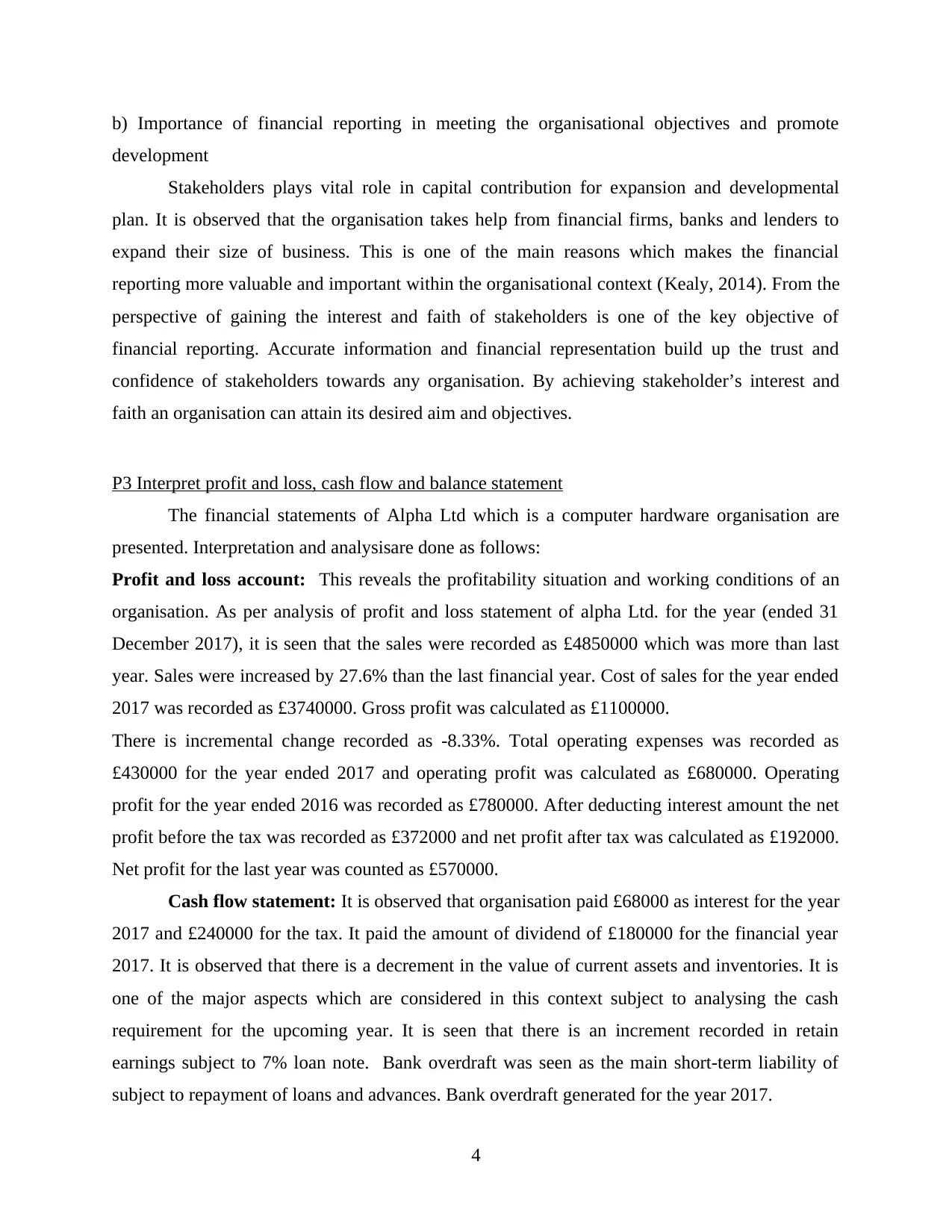
b) Importance of financial reporting in meeting the organisational objectives and promote
development
Stakeholders plays vital role in capital contribution for expansion and developmental
plan. It is observed that the organisation takes help from financial firms, banks and lenders to
expand their size of business. This is one of the main reasons which makes the financial
reporting more valuable and important within the organisational context (Kealy, 2014). From the
perspective of gaining the interest and faith of stakeholders is one of the key objective of
financial reporting. Accurate information and financial representation build up the trust and
confidence of stakeholders towards any organisation. By achieving stakeholder’s interest and
faith an organisation can attain its desired aim and objectives.
P3 Interpret profit and loss, cash flow and balance statement
The financial statements of Alpha Ltd which is a computer hardware organisation are
presented. Interpretation and analysisare done as follows:
Profit and loss account: This reveals the profitability situation and working conditions of an
organisation. As per analysis of profit and loss statement of alpha Ltd. for the year (ended 31
December 2017), it is seen that the sales were recorded as £4850000 which was more than last
year. Sales were increased by 27.6% than the last financial year. Cost of sales for the year ended
2017 was recorded as £3740000. Gross profit was calculated as £1100000.
There is incremental change recorded as -8.33%. Total operating expenses was recorded as
£430000 for the year ended 2017 and operating profit was calculated as £680000. Operating
profit for the year ended 2016 was recorded as £780000. After deducting interest amount the net
profit before the tax was recorded as £372000 and net profit after tax was calculated as £192000.
Net profit for the last year was counted as £570000.
Cash flow statement: It is observed that organisation paid £68000 as interest for the year
2017 and £240000 for the tax. It paid the amount of dividend of £180000 for the financial year
2017. It is observed that there is a decrement in the value of current assets and inventories. It is
one of the major aspects which are considered in this context subject to analysing the cash
requirement for the upcoming year. It is seen that there is an increment recorded in retain
earnings subject to 7% loan note. Bank overdraft was seen as the main short-term liability of
subject to repayment of loans and advances. Bank overdraft generated for the year 2017.
4
development
Stakeholders plays vital role in capital contribution for expansion and developmental
plan. It is observed that the organisation takes help from financial firms, banks and lenders to
expand their size of business. This is one of the main reasons which makes the financial
reporting more valuable and important within the organisational context (Kealy, 2014). From the
perspective of gaining the interest and faith of stakeholders is one of the key objective of
financial reporting. Accurate information and financial representation build up the trust and
confidence of stakeholders towards any organisation. By achieving stakeholder’s interest and
faith an organisation can attain its desired aim and objectives.
P3 Interpret profit and loss, cash flow and balance statement
The financial statements of Alpha Ltd which is a computer hardware organisation are
presented. Interpretation and analysisare done as follows:
Profit and loss account: This reveals the profitability situation and working conditions of an
organisation. As per analysis of profit and loss statement of alpha Ltd. for the year (ended 31
December 2017), it is seen that the sales were recorded as £4850000 which was more than last
year. Sales were increased by 27.6% than the last financial year. Cost of sales for the year ended
2017 was recorded as £3740000. Gross profit was calculated as £1100000.
There is incremental change recorded as -8.33%. Total operating expenses was recorded as
£430000 for the year ended 2017 and operating profit was calculated as £680000. Operating
profit for the year ended 2016 was recorded as £780000. After deducting interest amount the net
profit before the tax was recorded as £372000 and net profit after tax was calculated as £192000.
Net profit for the last year was counted as £570000.
Cash flow statement: It is observed that organisation paid £68000 as interest for the year
2017 and £240000 for the tax. It paid the amount of dividend of £180000 for the financial year
2017. It is observed that there is a decrement in the value of current assets and inventories. It is
one of the major aspects which are considered in this context subject to analysing the cash
requirement for the upcoming year. It is seen that there is an increment recorded in retain
earnings subject to 7% loan note. Bank overdraft was seen as the main short-term liability of
subject to repayment of loans and advances. Bank overdraft generated for the year 2017.
4
⊘ This is a preview!⊘
Do you want full access?
Subscribe today to unlock all pages.

Trusted by 1+ million students worldwide
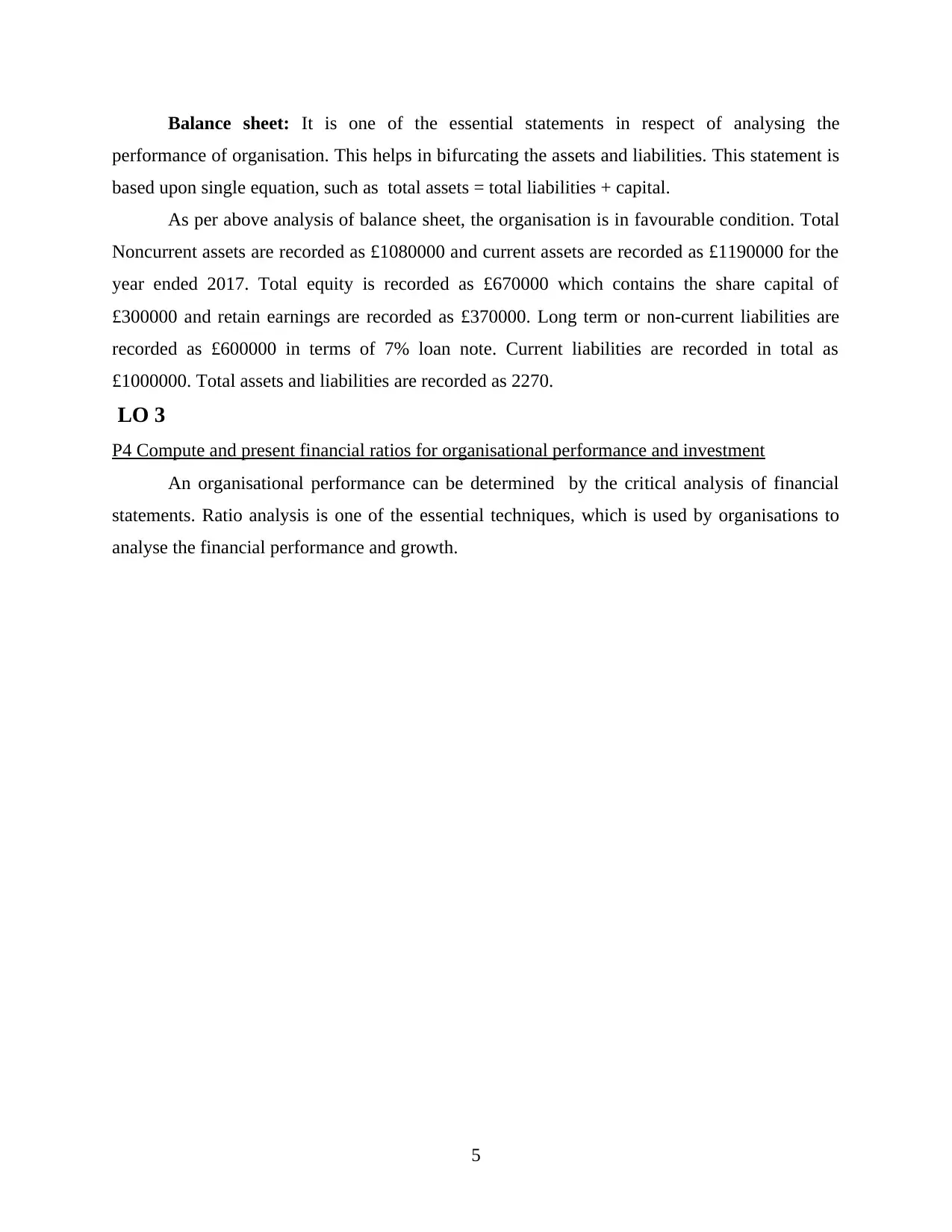
Balance sheet: It is one of the essential statements in respect of analysing the
performance of organisation. This helps in bifurcating the assets and liabilities. This statement is
based upon single equation, such as total assets = total liabilities + capital.
As per above analysis of balance sheet, the organisation is in favourable condition. Total
Noncurrent assets are recorded as £1080000 and current assets are recorded as £1190000 for the
year ended 2017. Total equity is recorded as £670000 which contains the share capital of
£300000 and retain earnings are recorded as £370000. Long term or non-current liabilities are
recorded as £600000 in terms of 7% loan note. Current liabilities are recorded in total as
£1000000. Total assets and liabilities are recorded as 2270.
LO 3
P4 Compute and present financial ratios for organisational performance and investment
An organisational performance can be determined by the critical analysis of financial
statements. Ratio analysis is one of the essential techniques, which is used by organisations to
analyse the financial performance and growth.
5
performance of organisation. This helps in bifurcating the assets and liabilities. This statement is
based upon single equation, such as total assets = total liabilities + capital.
As per above analysis of balance sheet, the organisation is in favourable condition. Total
Noncurrent assets are recorded as £1080000 and current assets are recorded as £1190000 for the
year ended 2017. Total equity is recorded as £670000 which contains the share capital of
£300000 and retain earnings are recorded as £370000. Long term or non-current liabilities are
recorded as £600000 in terms of 7% loan note. Current liabilities are recorded in total as
£1000000. Total assets and liabilities are recorded as 2270.
LO 3
P4 Compute and present financial ratios for organisational performance and investment
An organisational performance can be determined by the critical analysis of financial
statements. Ratio analysis is one of the essential techniques, which is used by organisations to
analyse the financial performance and growth.
5
Paraphrase This Document
Need a fresh take? Get an instant paraphrase of this document with our AI Paraphraser
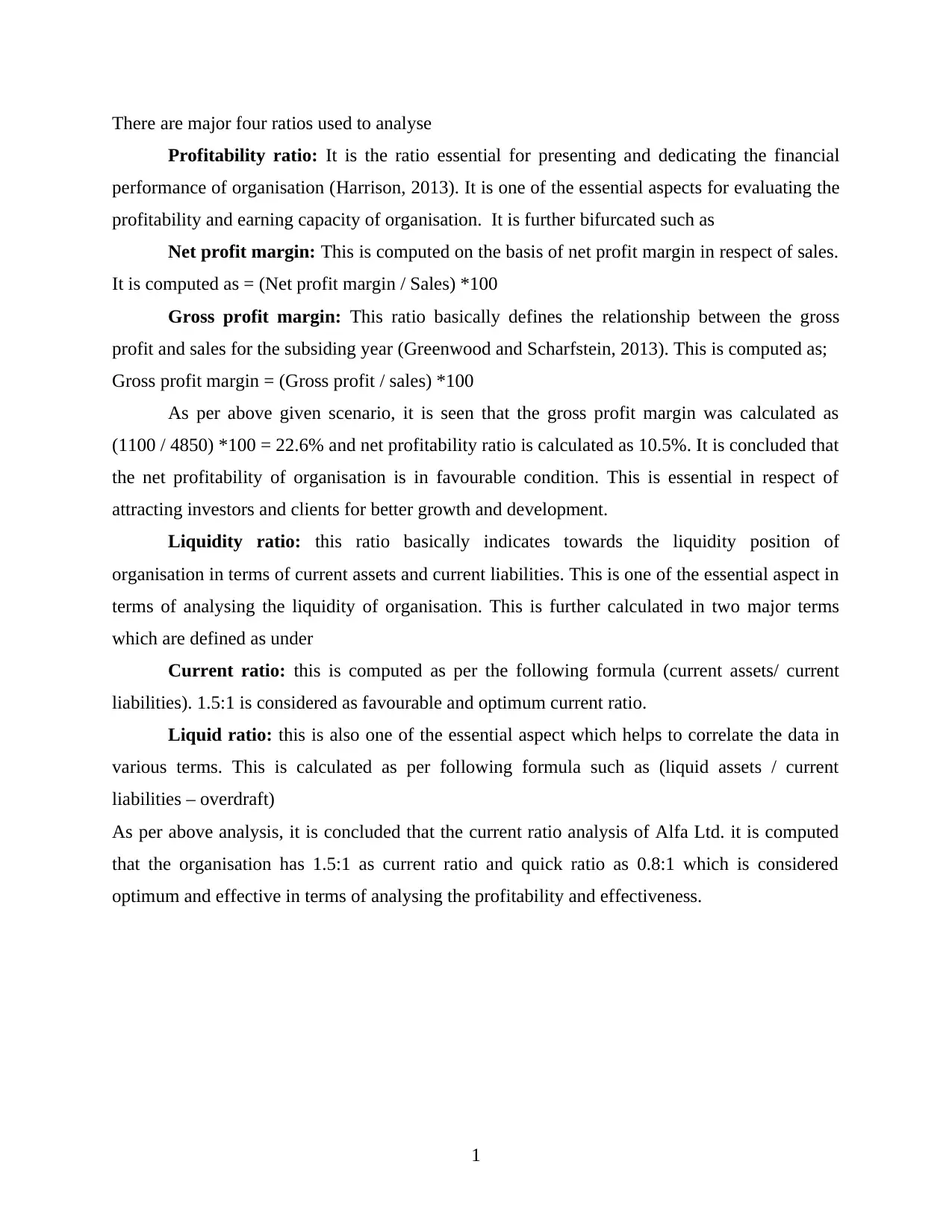
There are major four ratios used to analyse
Profitability ratio: It is the ratio essential for presenting and dedicating the financial
performance of organisation (Harrison, 2013). It is one of the essential aspects for evaluating the
profitability and earning capacity of organisation. It is further bifurcated such as
Net profit margin: This is computed on the basis of net profit margin in respect of sales.
It is computed as = (Net profit margin / Sales) *100
Gross profit margin: This ratio basically defines the relationship between the gross
profit and sales for the subsiding year (Greenwood and Scharfstein, 2013). This is computed as;
Gross profit margin = (Gross profit / sales) *100
As per above given scenario, it is seen that the gross profit margin was calculated as
(1100 / 4850) *100 = 22.6% and net profitability ratio is calculated as 10.5%. It is concluded that
the net profitability of organisation is in favourable condition. This is essential in respect of
attracting investors and clients for better growth and development.
Liquidity ratio: this ratio basically indicates towards the liquidity position of
organisation in terms of current assets and current liabilities. This is one of the essential aspect in
terms of analysing the liquidity of organisation. This is further calculated in two major terms
which are defined as under
Current ratio: this is computed as per the following formula (current assets/ current
liabilities). 1.5:1 is considered as favourable and optimum current ratio.
Liquid ratio: this is also one of the essential aspect which helps to correlate the data in
various terms. This is calculated as per following formula such as (liquid assets / current
liabilities – overdraft)
As per above analysis, it is concluded that the current ratio analysis of Alfa Ltd. it is computed
that the organisation has 1.5:1 as current ratio and quick ratio as 0.8:1 which is considered
optimum and effective in terms of analysing the profitability and effectiveness.
1
Profitability ratio: It is the ratio essential for presenting and dedicating the financial
performance of organisation (Harrison, 2013). It is one of the essential aspects for evaluating the
profitability and earning capacity of organisation. It is further bifurcated such as
Net profit margin: This is computed on the basis of net profit margin in respect of sales.
It is computed as = (Net profit margin / Sales) *100
Gross profit margin: This ratio basically defines the relationship between the gross
profit and sales for the subsiding year (Greenwood and Scharfstein, 2013). This is computed as;
Gross profit margin = (Gross profit / sales) *100
As per above given scenario, it is seen that the gross profit margin was calculated as
(1100 / 4850) *100 = 22.6% and net profitability ratio is calculated as 10.5%. It is concluded that
the net profitability of organisation is in favourable condition. This is essential in respect of
attracting investors and clients for better growth and development.
Liquidity ratio: this ratio basically indicates towards the liquidity position of
organisation in terms of current assets and current liabilities. This is one of the essential aspect in
terms of analysing the liquidity of organisation. This is further calculated in two major terms
which are defined as under
Current ratio: this is computed as per the following formula (current assets/ current
liabilities). 1.5:1 is considered as favourable and optimum current ratio.
Liquid ratio: this is also one of the essential aspect which helps to correlate the data in
various terms. This is calculated as per following formula such as (liquid assets / current
liabilities – overdraft)
As per above analysis, it is concluded that the current ratio analysis of Alfa Ltd. it is computed
that the organisation has 1.5:1 as current ratio and quick ratio as 0.8:1 which is considered
optimum and effective in terms of analysing the profitability and effectiveness.
1
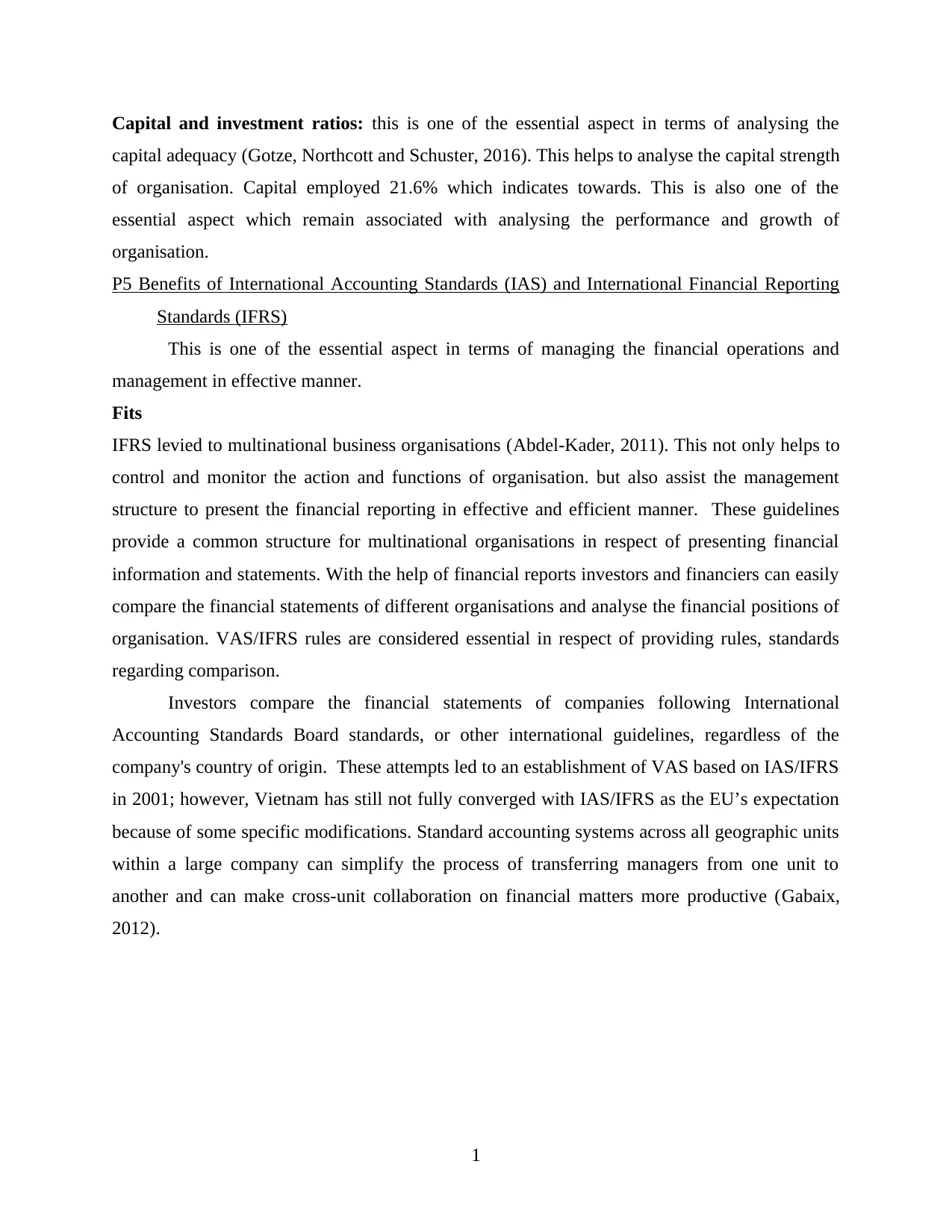
Capital and investment ratios: this is one of the essential aspect in terms of analysing the
capital adequacy (Gotze, Northcott and Schuster, 2016). This helps to analyse the capital strength
of organisation. Capital employed 21.6% which indicates towards. This is also one of the
essential aspect which remain associated with analysing the performance and growth of
organisation.
P5 Benefits of International Accounting Standards (IAS) and International Financial Reporting
Standards (IFRS)
This is one of the essential aspect in terms of managing the financial operations and
management in effective manner.
Fits
IFRS levied to multinational business organisations (Abdel-Kader, 2011). This not only helps to
control and monitor the action and functions of organisation. but also assist the management
structure to present the financial reporting in effective and efficient manner. These guidelines
provide a common structure for multinational organisations in respect of presenting financial
information and statements. With the help of financial reports investors and financiers can easily
compare the financial statements of different organisations and analyse the financial positions of
organisation. VAS/IFRS rules are considered essential in respect of providing rules, standards
regarding comparison.
Investors compare the financial statements of companies following International
Accounting Standards Board standards, or other international guidelines, regardless of the
company's country of origin. These attempts led to an establishment of VAS based on IAS/IFRS
in 2001; however, Vietnam has still not fully converged with IAS/IFRS as the EU’s expectation
because of some specific modifications. Standard accounting systems across all geographic units
within a large company can simplify the process of transferring managers from one unit to
another and can make cross-unit collaboration on financial matters more productive (Gabaix,
2012).
1
capital adequacy (Gotze, Northcott and Schuster, 2016). This helps to analyse the capital strength
of organisation. Capital employed 21.6% which indicates towards. This is also one of the
essential aspect which remain associated with analysing the performance and growth of
organisation.
P5 Benefits of International Accounting Standards (IAS) and International Financial Reporting
Standards (IFRS)
This is one of the essential aspect in terms of managing the financial operations and
management in effective manner.
Fits
IFRS levied to multinational business organisations (Abdel-Kader, 2011). This not only helps to
control and monitor the action and functions of organisation. but also assist the management
structure to present the financial reporting in effective and efficient manner. These guidelines
provide a common structure for multinational organisations in respect of presenting financial
information and statements. With the help of financial reports investors and financiers can easily
compare the financial statements of different organisations and analyse the financial positions of
organisation. VAS/IFRS rules are considered essential in respect of providing rules, standards
regarding comparison.
Investors compare the financial statements of companies following International
Accounting Standards Board standards, or other international guidelines, regardless of the
company's country of origin. These attempts led to an establishment of VAS based on IAS/IFRS
in 2001; however, Vietnam has still not fully converged with IAS/IFRS as the EU’s expectation
because of some specific modifications. Standard accounting systems across all geographic units
within a large company can simplify the process of transferring managers from one unit to
another and can make cross-unit collaboration on financial matters more productive (Gabaix,
2012).
1
⊘ This is a preview!⊘
Do you want full access?
Subscribe today to unlock all pages.

Trusted by 1+ million students worldwide
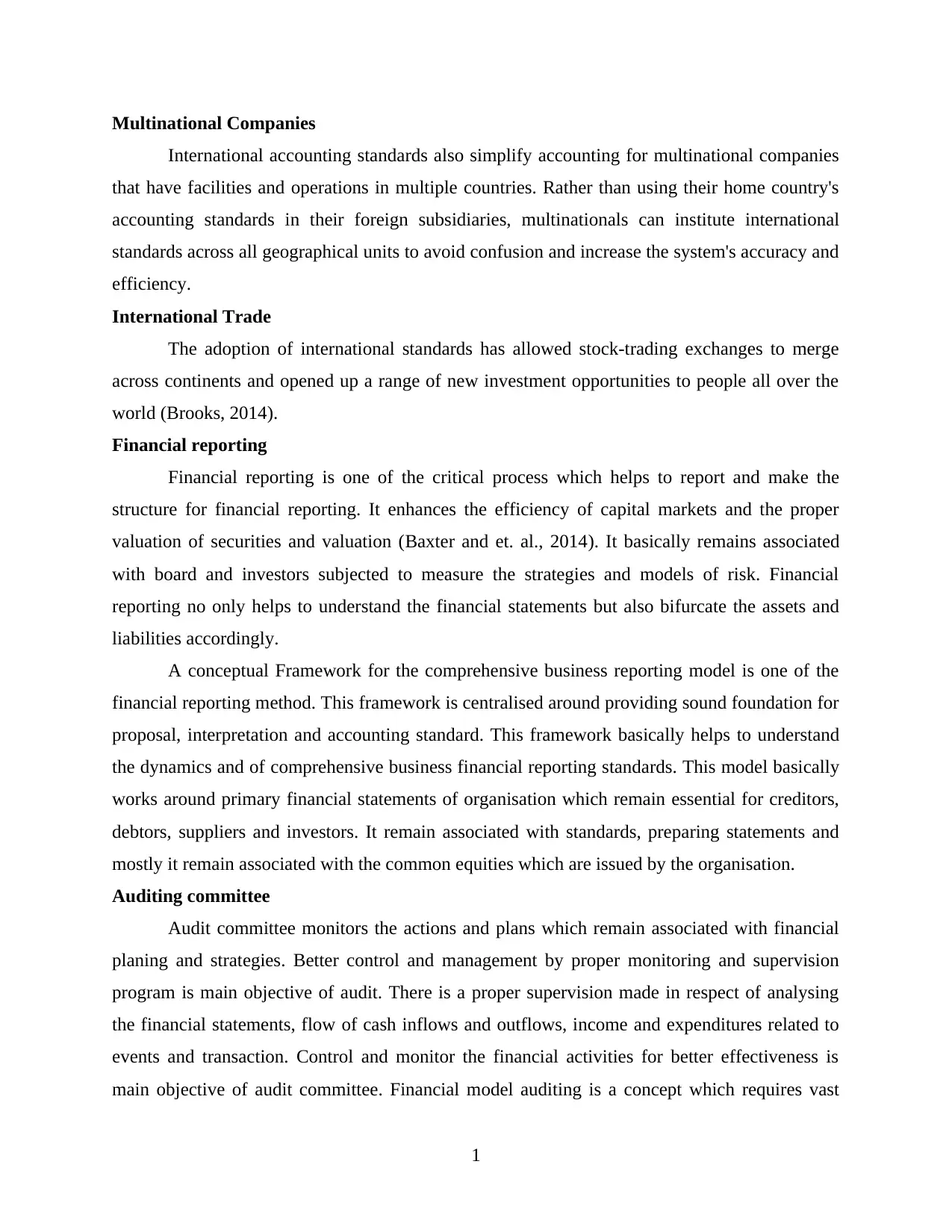
Multinational Companies
International accounting standards also simplify accounting for multinational companies
that have facilities and operations in multiple countries. Rather than using their home country's
accounting standards in their foreign subsidiaries, multinationals can institute international
standards across all geographical units to avoid confusion and increase the system's accuracy and
efficiency.
International Trade
The adoption of international standards has allowed stock-trading exchanges to merge
across continents and opened up a range of new investment opportunities to people all over the
world (Brooks, 2014).
Financial reporting
Financial reporting is one of the critical process which helps to report and make the
structure for financial reporting. It enhances the efficiency of capital markets and the proper
valuation of securities and valuation (Baxter and et. al., 2014). It basically remains associated
with board and investors subjected to measure the strategies and models of risk. Financial
reporting no only helps to understand the financial statements but also bifurcate the assets and
liabilities accordingly.
A conceptual Framework for the comprehensive business reporting model is one of the
financial reporting method. This framework is centralised around providing sound foundation for
proposal, interpretation and accounting standard. This framework basically helps to understand
the dynamics and of comprehensive business financial reporting standards. This model basically
works around primary financial statements of organisation which remain essential for creditors,
debtors, suppliers and investors. It remain associated with standards, preparing statements and
mostly it remain associated with the common equities which are issued by the organisation.
Auditing committee
Audit committee monitors the actions and plans which remain associated with financial
planing and strategies. Better control and management by proper monitoring and supervision
program is main objective of audit. There is a proper supervision made in respect of analysing
the financial statements, flow of cash inflows and outflows, income and expenditures related to
events and transaction. Control and monitor the financial activities for better effectiveness is
main objective of audit committee. Financial model auditing is a concept which requires vast
1
International accounting standards also simplify accounting for multinational companies
that have facilities and operations in multiple countries. Rather than using their home country's
accounting standards in their foreign subsidiaries, multinationals can institute international
standards across all geographical units to avoid confusion and increase the system's accuracy and
efficiency.
International Trade
The adoption of international standards has allowed stock-trading exchanges to merge
across continents and opened up a range of new investment opportunities to people all over the
world (Brooks, 2014).
Financial reporting
Financial reporting is one of the critical process which helps to report and make the
structure for financial reporting. It enhances the efficiency of capital markets and the proper
valuation of securities and valuation (Baxter and et. al., 2014). It basically remains associated
with board and investors subjected to measure the strategies and models of risk. Financial
reporting no only helps to understand the financial statements but also bifurcate the assets and
liabilities accordingly.
A conceptual Framework for the comprehensive business reporting model is one of the
financial reporting method. This framework is centralised around providing sound foundation for
proposal, interpretation and accounting standard. This framework basically helps to understand
the dynamics and of comprehensive business financial reporting standards. This model basically
works around primary financial statements of organisation which remain essential for creditors,
debtors, suppliers and investors. It remain associated with standards, preparing statements and
mostly it remain associated with the common equities which are issued by the organisation.
Auditing committee
Audit committee monitors the actions and plans which remain associated with financial
planing and strategies. Better control and management by proper monitoring and supervision
program is main objective of audit. There is a proper supervision made in respect of analysing
the financial statements, flow of cash inflows and outflows, income and expenditures related to
events and transaction. Control and monitor the financial activities for better effectiveness is
main objective of audit committee. Financial model auditing is a concept which requires vast
1
Paraphrase This Document
Need a fresh take? Get an instant paraphrase of this document with our AI Paraphraser
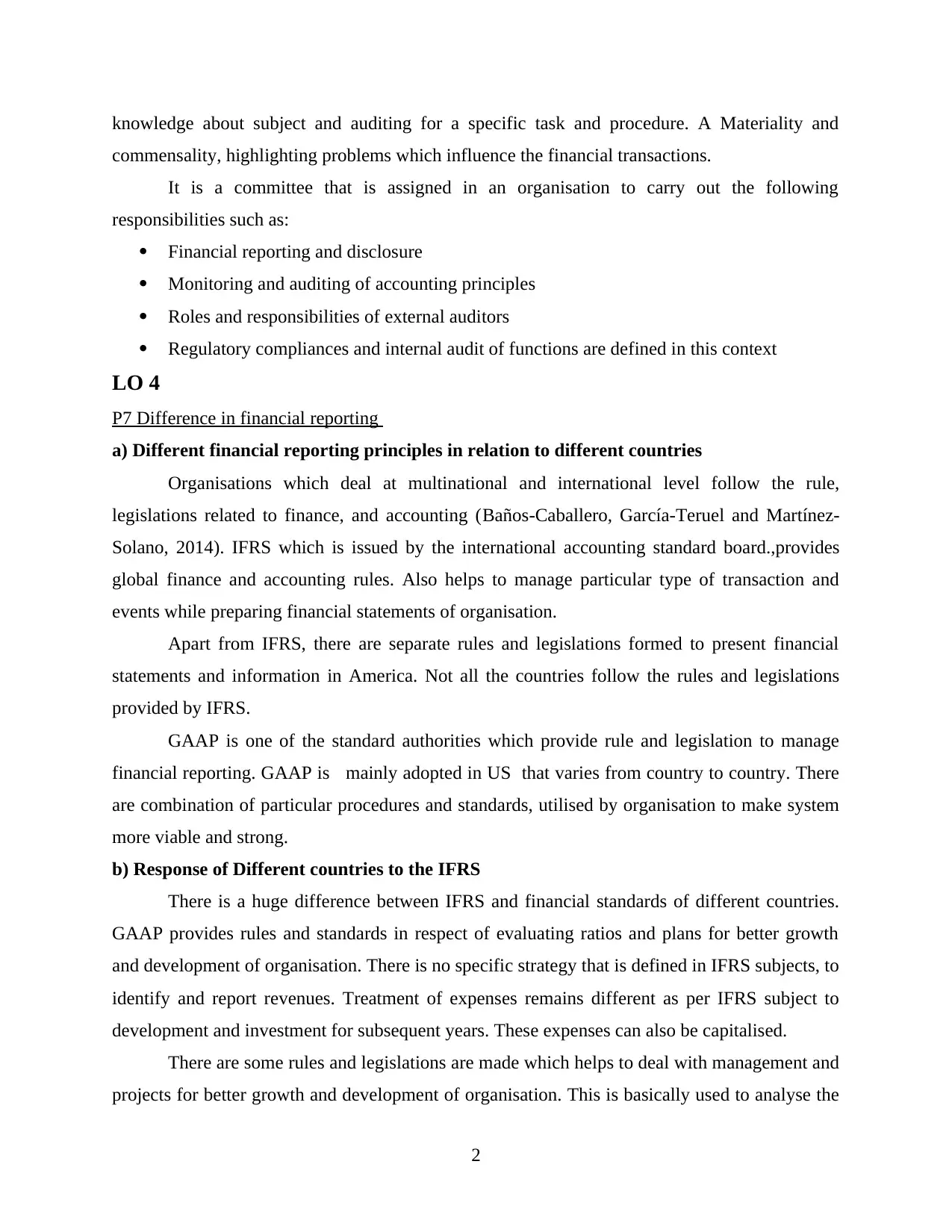
knowledge about subject and auditing for a specific task and procedure. A Materiality and
commensality, highlighting problems which influence the financial transactions.
It is a committee that is assigned in an organisation to carry out the following
responsibilities such as:
Financial reporting and disclosure
Monitoring and auditing of accounting principles
Roles and responsibilities of external auditors
Regulatory compliances and internal audit of functions are defined in this context
LO 4
P7 Difference in financial reporting
a) Different financial reporting principles in relation to different countries
Organisations which deal at multinational and international level follow the rule,
legislations related to finance, and accounting (Baños-Caballero, García-Teruel and Martínez-
Solano, 2014). IFRS which is issued by the international accounting standard board.,provides
global finance and accounting rules. Also helps to manage particular type of transaction and
events while preparing financial statements of organisation.
Apart from IFRS, there are separate rules and legislations formed to present financial
statements and information in America. Not all the countries follow the rules and legislations
provided by IFRS.
GAAP is one of the standard authorities which provide rule and legislation to manage
financial reporting. GAAP is mainly adopted in US that varies from country to country. There
are combination of particular procedures and standards, utilised by organisation to make system
more viable and strong.
b) Response of Different countries to the IFRS
There is a huge difference between IFRS and financial standards of different countries.
GAAP provides rules and standards in respect of evaluating ratios and plans for better growth
and development of organisation. There is no specific strategy that is defined in IFRS subjects, to
identify and report revenues. Treatment of expenses remains different as per IFRS subject to
development and investment for subsequent years. These expenses can also be capitalised.
There are some rules and legislations are made which helps to deal with management and
projects for better growth and development of organisation. This is basically used to analyse the
2
commensality, highlighting problems which influence the financial transactions.
It is a committee that is assigned in an organisation to carry out the following
responsibilities such as:
Financial reporting and disclosure
Monitoring and auditing of accounting principles
Roles and responsibilities of external auditors
Regulatory compliances and internal audit of functions are defined in this context
LO 4
P7 Difference in financial reporting
a) Different financial reporting principles in relation to different countries
Organisations which deal at multinational and international level follow the rule,
legislations related to finance, and accounting (Baños-Caballero, García-Teruel and Martínez-
Solano, 2014). IFRS which is issued by the international accounting standard board.,provides
global finance and accounting rules. Also helps to manage particular type of transaction and
events while preparing financial statements of organisation.
Apart from IFRS, there are separate rules and legislations formed to present financial
statements and information in America. Not all the countries follow the rules and legislations
provided by IFRS.
GAAP is one of the standard authorities which provide rule and legislation to manage
financial reporting. GAAP is mainly adopted in US that varies from country to country. There
are combination of particular procedures and standards, utilised by organisation to make system
more viable and strong.
b) Response of Different countries to the IFRS
There is a huge difference between IFRS and financial standards of different countries.
GAAP provides rules and standards in respect of evaluating ratios and plans for better growth
and development of organisation. There is no specific strategy that is defined in IFRS subjects, to
identify and report revenues. Treatment of expenses remains different as per IFRS subject to
development and investment for subsequent years. These expenses can also be capitalised.
There are some rules and legislations are made which helps to deal with management and
projects for better growth and development of organisation. This is basically used to analyse the
2
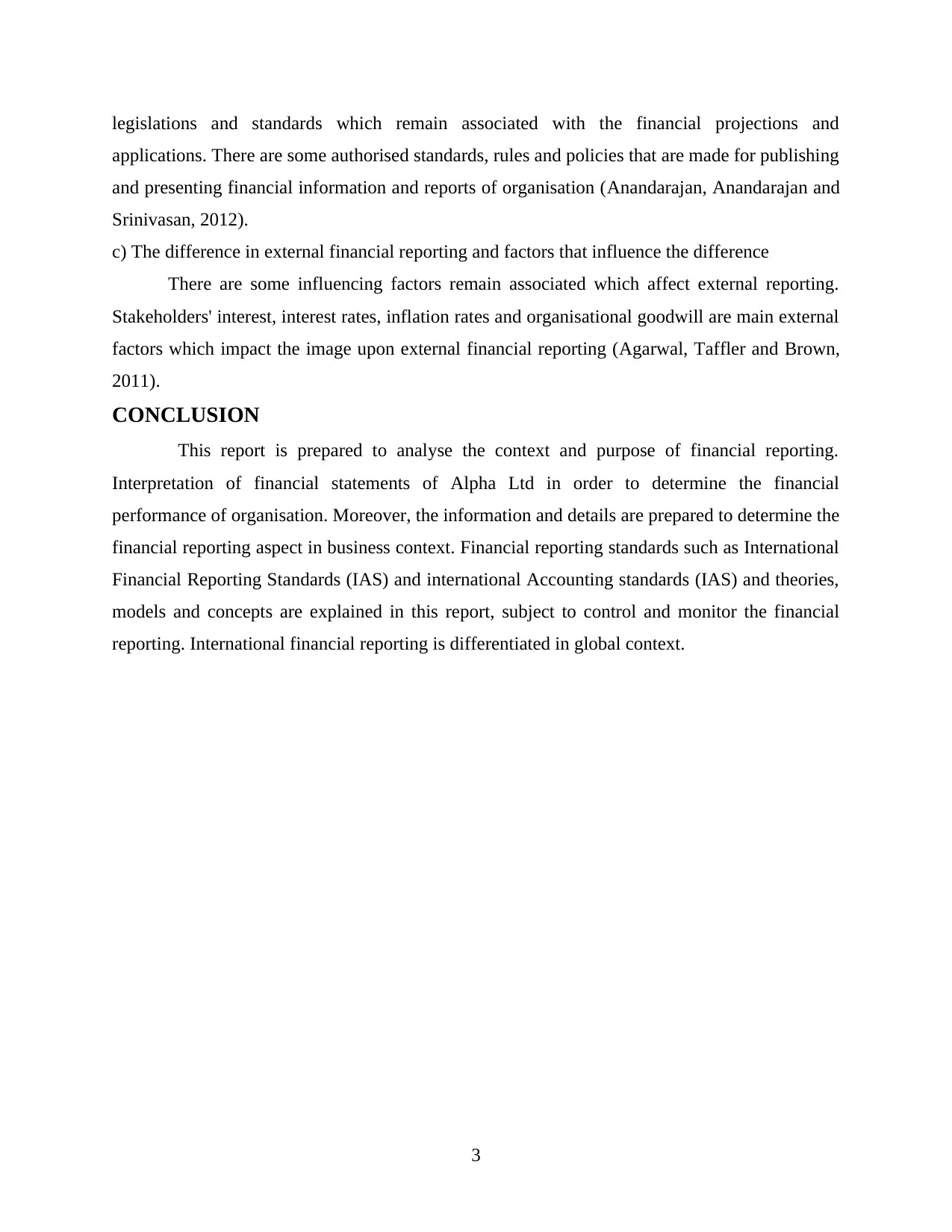
legislations and standards which remain associated with the financial projections and
applications. There are some authorised standards, rules and policies that are made for publishing
and presenting financial information and reports of organisation (Anandarajan, Anandarajan and
Srinivasan, 2012).
c) The difference in external financial reporting and factors that influence the difference
There are some influencing factors remain associated which affect external reporting.
Stakeholders' interest, interest rates, inflation rates and organisational goodwill are main external
factors which impact the image upon external financial reporting (Agarwal, Taffler and Brown,
2011).
CONCLUSION
This report is prepared to analyse the context and purpose of financial reporting.
Interpretation of financial statements of Alpha Ltd in order to determine the financial
performance of organisation. Moreover, the information and details are prepared to determine the
financial reporting aspect in business context. Financial reporting standards such as International
Financial Reporting Standards (IAS) and international Accounting standards (IAS) and theories,
models and concepts are explained in this report, subject to control and monitor the financial
reporting. International financial reporting is differentiated in global context.
3
applications. There are some authorised standards, rules and policies that are made for publishing
and presenting financial information and reports of organisation (Anandarajan, Anandarajan and
Srinivasan, 2012).
c) The difference in external financial reporting and factors that influence the difference
There are some influencing factors remain associated which affect external reporting.
Stakeholders' interest, interest rates, inflation rates and organisational goodwill are main external
factors which impact the image upon external financial reporting (Agarwal, Taffler and Brown,
2011).
CONCLUSION
This report is prepared to analyse the context and purpose of financial reporting.
Interpretation of financial statements of Alpha Ltd in order to determine the financial
performance of organisation. Moreover, the information and details are prepared to determine the
financial reporting aspect in business context. Financial reporting standards such as International
Financial Reporting Standards (IAS) and international Accounting standards (IAS) and theories,
models and concepts are explained in this report, subject to control and monitor the financial
reporting. International financial reporting is differentiated in global context.
3
⊘ This is a preview!⊘
Do you want full access?
Subscribe today to unlock all pages.

Trusted by 1+ million students worldwide
1 out of 13
Related Documents
Your All-in-One AI-Powered Toolkit for Academic Success.
+13062052269
info@desklib.com
Available 24*7 on WhatsApp / Email
![[object Object]](/_next/static/media/star-bottom.7253800d.svg)
Unlock your academic potential
Copyright © 2020–2025 A2Z Services. All Rights Reserved. Developed and managed by ZUCOL.





